List of largest empires
This article has multiple issues. Please help improve it or discuss these issues on the talk page. (Learn how and when to remove these template messages)
No issues specified. Please specify issues, or remove this template. |
An empire involves the extension of a state's sovereignty over external territories. For example, first the Spanish Empire and then the British Empire were called "the empires on which the sun never sets", because of their territories and possessions around the globe. This article provides a list of the largest empires in world history.
Measurement details
The calculation of the land area of a particular empire is controversial. In general, the list centers on the side of including any land area that was explored and explicitly claimed, even if the areas were populated very sparsely or not at all. For example, a large portion of Northern Siberia is included in the size of the Russian Empire but not the Mongol Empire. The Mongol Empire's northern border was somewhat ill-defined, but in most places it was simply the natural border between the steppe and the taiga. Occupied areas north of this are included at the time the majority of the taiga and tundra were unexplored and uninhabited. This area was only very sparsely populated by the Russian Empire, but it had been explicitly claimed by the Russian Empire by the 17th century, and its extent had been entirely explored by the late 19th century. Similarly, the northernmost Canadian islands such as Ellesmere Island were explored and claimed by the British Empire by the mid-19th century (virtually the entire mainland was at least sparsely populated well before that).
The only claims on mainland Antarctica are included in the area of the British Empire.
Due to the historical trend of increasing population and GDP, the list of largest empires in these categories is highly dependent on which relatively recent political entities are defined as empires. The measures of population and GDP as a percentage of the world total take into account this historical growth, although decent GDP data is only available for the last few centuries, accurate only for the last decades.
Debates regarding definition of imperial domains
Compilations of history’s largest empires (in both geographical size and population) often vary due to differing definitions of imperial borders throughout history and across distinct historical traditions. Imperial domains have been variously defined in terms of direct administrative rule from a common ruling authority, military presence, colonization and settlement, collection of tribute, economic dependence, or even incorporation into a common trading or ideological network. Many imperial domains have therefore enjoyed varying degrees of autonomy, self-rule, or even outright independence (though sometimes with a dependent or protectorate relationship to a stronger power). Some regions claimed by an imperial authority have been large, yet arid and very sparsely populated lands without much administrative control whatsoever. Therefore, empires can vary in size according to these designations, often quite significantly.
For example in India, which experienced varying levels of European contact and imperial forays since Vasco da Gama’s expeditions in 1497-1498, French, Dutch, Portuguese and especially British authorities claimed authority over increasing portions of the Indian Subcontinent. This process culminated in the period of the British Raj (and its smaller French and Portuguese counterparts) after 1857. Nevertheless, even then approximately half of Indian territory consisted of Princely States under de facto and de jure rule of local rajas and maharajas. While the Indian princes often sought protection and mediation from the European maritime powers, they minted their own coins, issued their own edicts, and otherwise ruled of their own accord; furthermore, the Indian independence Act, which ended the British presence by 1948, did not apply to the Princely States, which required separate negotiations with the new Indian nation as independent states in themselves. Thus, although many European maps showed nearly the whole of India as a predominantly British colony in the late 19th century, close to 50% was essentially independent, and the Indian historical tradition in particular does not consider the large and populous region ruled by these rajas to have been under Western rule.
Another issue is that many of history’s empires have ruled over vast and mostly uninhabited territorial expanses, sparsely populated by largely autonomous tribes, and with little in the way of direct administration or settlement by an imperial power. For example, various Mongol khanates from the 13th century established dominion over arid steppes in Central Asia and Siberia that were difficult to control from a central authority, as was the case with the expansionist Tsardom of Russia empires from the 17th century, which established control in the same regions. In both cases, administrative structures and settlements were gradually introduced into the regions—with Russian settlers, for example, initiating forts and frontier cities in the 19th century in particular—and so the size of each empire in any given decade would depend on how strict one’s criteria are in regard to the presence of true settlement and administration. Likewise, in more recent history, almost half the land expanse that is often regarded as part of the British Empire (and also much of the historical French Empire in North America), consisted of essentially barren and uninhabitable terrain in Canada and the interior of Australia, which was often difficult to even map, let alone settle and administer. Even today, the population of those regions (particularly in Nunavut and the Northwest Territories of Canada) consists largely of sparse settlements of self-governing indigenous peoples, with little in the way of submission to a central ruling authority.
During the Muslim conquests of the 7th and early 8th centuries, Rashidun armies established the Caliphate, or Islamic Empire, one of the largest empires ever. The 7th century saw the introduction of Islam in the Arabian Peninsula, where The Prophet Muhammad established a new unified political polity in the Arabian peninsula which under the subsequent Rashidun and Umayyad Caliphates saw a century of rapid expansion of Arab power well beyond the Arabian peninsula in the form of a vast Muslim Arab Empire with an area of influence that stretched from northwest India, across Central Asia, the Middle East, North Africa, southern Italy, and the Iberian Peninsula, to the Pyrenees. However, internal feuding among ruling figures in the empire led it to fragment into several states under separate administrations, such as the Umayyads (whose rule continued in Spain after it collapsed elsewhere), Abbasids, Ayyubids, Mamluks and many others. These were in addition to a variety of other Muslim states in Sudan, Indonesia and elsewhere that later arose outside of the main Islamic Empires, through trade and other contacts. Thus, the size of these empires vary depending on how “membership” in the empire is defined—as being under a single administration, accepting a particular ruler or following the dictates of the Caliph (which technically, Sunni Muslims in general were expected to do).
Similarly, the Mongol Empire lost its unity upon the death of the Great Khan Möngke during fighting in China in 1259, with the Golden Horde’s Berke Khan and the Il-Khanate’s Hulegu Khan even taking up arms against each other and supporting rival factions for selection of the Great Khan. However, upon the death of Berke—a Muslim—the religious impetus for conflict among the khanates subsided, with the Mongols again supposedly loyal to the new Great Khan Kublai before fragmenting yet again later. If the khanates are considered to have been a unified Mongol Empire under Kublai—stretching from Korea and China in the east through Siberia and Central Asia and into Persia and Eastern Europe in the west—it would easily be the world’s largest in terms of both land area and population (as a percentage of the world total). A related question arises with the granting of dominion and commonwealth statuses among former imperial domains, in which the domains acquire a high degree of self-rule, equivalent to independence in some estimations. For example, Australia attained dominion status in 1901 which may or may not have indicated a departure from the British Empire, depending on interpretation of the status.
Finally, many of history’s empires have had unusual arrangements among multiple powers, such as joint rule by several authorities, layers of rule (with different powers assuming different levels of administrative authority), territorial division with blurred boundaries or other forms of empire without a single obvious central authority. For example, the Manchus, who established the Qing Dynasty in 17th-century China, also conquered nomadic lands to the north, including Mongolia. The Manchus increasingly merged with the Chinese population over the centuries, so that the administration took on both Manchu and Chinese features with no clear division among them. The Mongol chieftains of Outer Mongolia in particular, pledged loyalty to the Manchus but retained substantial autonomy, and when the Qing Dynasty collapsed in the early 20th century, the status of Outer Mongolia relative to the new Chinese state became unclear. Britain had a very complicated arrangement with Egypt and Sudan. Egyptian forces battled the British in the Alexandria Expedition in 1807, but in the wake of this, British officials exerted varying degrees of sway in Egypt especially by the late 19th century, with the French also assuming a role in the Suez Canal territory. Sudan, in turn, was technically a colony of the Egyptians, but the British exerted de facto sway on Sudan indirectly via Egypt. Thus, accounts vary on the imperial status (or lack thereof) of both Egypt and Sudan. Lastly, in the wake of the Bolshevik Revolution, many nations took on a Communist character and attached themselves to the global Communist center of the Soviet Union. Mongolia, North Korea, and China following Communist victory in the Chinese civil war, all took guidance from the Soviet Union especially in the years just after their Communist transformations. The Soviet Union also exercised varying control over Eastern Europe via the Warsaw Pact even though the Pact countries were formally independent, while Communist nations in Africa and Latin America also sought Soviet guidance. Therefore, the lists of largest empires below represent merely a sample of possible rankings depending on the specific criteria used to define an empire.
European colonial empires
The first global empires were a product of the European Age of Exploration that began with a race of exploration between the then most advanced maritime powers, Portugal and Spain, in the 15th century. The initial impulse behind these maritime empires and those that followed was trade, driven by the new ideas and the capitalism that grew out of the European Renaissance. Agreements were also reached to divide the world up between them in 1479, 1493, and 1494.
Portugal began establishing the first global trade network and empire under the leadership of Henry the Navigator. Portugal would eventually establish colonial domains from Brazil, in South America, to several colonies in Africa (namely Portuguese Guinea, Cape Verde, São Tomé and Príncipe, Angola and Mozambique), in Portuguese India (most importantly Bombay and Goa), in China (Macau), and Oceania (most importantly Timor, namely East Timor), amongst many other smaller or short-lived possessions (see Evolution of the Portuguese Empire).
During its peak, the Spanish Empire had possession of the Netherlands, Luxembourg, Belgium, most of Italy, parts of Germany, parts of France, and many colonies in the Americas, Africa, Asia and Oceania. With the conquest of inland Mexico, Peru, and the Philippines in the 16th century, Spain established overseas dominions on a scale and world distribution that had never been approached by its predecessors (the Mongol Empire had been larger but was restricted to Eurasia). Possessions in Europe, Africa, the Atlantic Ocean, the Americas, the Pacific Ocean, and the Far East qualified the Spanish Empire as attaining a global presence in this sense.
From 1580 to 1640 the Portuguese Empire and the Spanish Empire were conjoined in a personal union of its Habsburg monarchs, during the period of the Iberian Union, though the empires continued to be administered separately.
Subsequent global empires included the French, Dutch, and British empires. The latter, consolidated during the period of British maritime hegemony in the 19th century, became the largest of all empires by virtue of the improved transportation technologies of the time. At its height, the British Empire covered a quarter of the Earth's land area and comprised a quarter of its population. Germany and Italy were unified later than the other major European countries and so they joined other European powers in establishing colonies overseas only during the "Scramble for Africa" in the 19th century. By the 1860s, the Russian Empire — continued as the Soviet Union — became the largest contiguous state in the world. Russia continues this distinction, despite having "lost" its Soviet periphery (Russia today includes slightly over half the world's longitudes).
-
Anachronous map of the Portuguese Empire
-
Anachronous map of the overseas Spanish Empire
-
Anachronous map of the Dutch Empire
-
Anachronous map of the British Empire
-
Anachronous map of the French Empire
-
Map of the German Empire in 1914
-
Map of the Italian Colonial Empire in 1939
-
A map of the Russian Empire
Largest empires by land area and population
For context, note that the total land area of the Earth is just under 149 million km2.[1]
All empires at their greatest extent
Notes:
- ^N Not a formal empire.
By era
Ancient empires

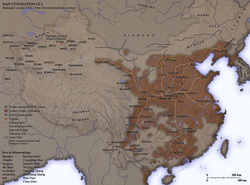
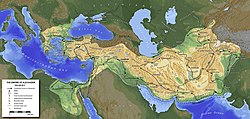

- Achaemenid Empire - 8.0 million km2 (480 BC)[19]
- Han Empire, China - 6.5 million km2 (AD 100)[22]
- Roman Empire - 5.5 million km2 (AD 117)[26][48]
- Macedonian Empire - 5.2 million km2 (323 BC)[2][31]
- Maurya Empire, India - 5.0 million km2 (250 BC)[2][49]
- Xin Dynasty, China - 4.7 million km2 (AD 10)[22]
- Xiongnu Empire - 4.03 million km2 (176 BC)[34][50]
- Hunnic Empire - 4.0 million km2 (AD 441)[22]
- Hapthalite Khanate (White Huns), India - 4.0 million km2 (AD 490)[22]
- Rouran Khaganate (Juan-juan) - 4.0 million km2 (AD 405)[2][22]
- Seleucid Empire - 3.9 million km2 (301 BC)[2][31]
- Kushan Empire, India - 3.8 million km2 (AD 200)[22][51]
- Sassanid Empire - 3.5 million km2 (AD 450)[2][31]
- Gupta Empire, India - 3.5 million km2 (AD 400)[2][52]
- Western Jin Dynasty, China - 3.5 million km2 (AD 300)[22]
- Median Empire - 2.8 million km2 (585 BC)[2][31]
- Qin Dynasty, China - 2.8 million km2 (206 BC)[22]
- Parthian Empire - 2.8 million km2 (AD 1)[2][31]
- Eastern Jin Dynasty, China - 2.8 million km2 (AD 347)[22]
- Liu Song Dynasty, China - 2.8 million km2 (AD 420)[22]
- Eastern Roman Empire (Byzantine Empire) - 2.8 million km2 (AD 450)[22]
- Indo-Greek (Yavana) Kingdom, India - 2.5 million km2 (150 BC)[22]
- Bactrian Empire - 2.5 million km2 (184 BC)[22]
- Later Zhao Dynasty, China - 2.5 million km2 (329)[22]
- Northern Wei Dynasty, China - 2.2 million km2 (AD 450)[22]
- Wei Dynasty, China - 2.0 million km2 (AD 263)[22]
- Former Qin Dynasty, China - 2.0 million km2 (AD 376)[22]
- Western Roman Empire - 2.0 million km2 (AD 395)[22]
- Earlier Zhao Dynasty, China - 2.0 million km2 (316)[22]
- Satavahana Empire (Salivahana), India - 2.0 million km2 (AD 90)[22]
- Indo-Parthians (Pahalvas) Kingdom , India - 1.5 million km2 (AD 50)[22]
- Wu Dynasty, China - 1.5 million km2 (AD 221)[22]
- Indo-Scythians (Shaka) Kingdom, India - 1.5 million km2 (BC 100)[31]
- Nanda Dynasty, India - 1.5 million km2 (350 or 321 BC)[22][44]
- Neo-Assyrian Empire - 1.4 million km2 (670 BC)[31]
- Shang Dynasty, China - 1.25 million km2 (1122 BC)[2][31]
- Western Zhou Dynasty, China - 1.25 million km2 (1122 BC)[31]
- Aksumite Empire - 1.25 million km2 (AD 350)[2]
- Sunga Empire, India - 1.2 million km2 (BC 150)[2]
- Kingdom of Kush (Meroë) (25th Dynasty), Sudan - 1.2 million km2 (BC 700)[2]
- 18th Dynasty, Egypt - 1.0 million km2 (1450 BC)[31]
- New Kingdom in Egypt - 1.0 million km2 (1300 BC)[2][31]
- Ptolemaic Empire, Egypt - 1.0 million km2 (301 BC)[31]
- Maha-Meghavahana Dynasty, India - 0.9 million km2 (10 BC)[31]
- Akkadian Empire - 0.8 million km2 (2250 BC)[31]
- Western Satraps Dynasty, India - 0.8 million km2 (AD 100)[22]
- Himyarite Kingdom, Yemen - 0.8 million km2 (400 AD)[31]
- Shu Dynasty, China - 0.7 million km2 (221)[22]
- 15th Dynasty (Hyksos), Egypt - 0.65 million km2 (1650 BC)[31]
- Vakataka Kingdom, India - 0.65 million km2 (450 AD)[31]
- 26th Dynasty, Egypt - 0.65 million km2 (550 BC)[31]
- Middle Kingdom, Egypt - 0.5 million km2 (1850 BC)[31]
- Lydian Empire - 0.5 million km2 (585 BC)[31]
- Neo-Babylonian Empire - 0.5 million km2 (562 BC)[31]
- Kosala Dynasty, India - 0.5 million km2 (543 BC)[22]
- Shishunaga Dynasty, India - 0.5 million km2 (510 BC)[22]
- Chu Dynasty, China - 0.5 million km2 (350 BC)[22]
- Kangju Empire (Transoxiana) - 0.5 million km2 (100 BC)[22]
- Goguryeo Kingdom, Korea - 0.45 million km2 (476)[31]
- Xia Dynasty, China (based on the hypothesis that prehistorical cities of Erlitou culture were once united) - 0.45 million km2 (1800 BC)[31]
- New Kingdom, Hittite - 0.45 million km2 (1250 or 1220 BC)[31]
- Armenian Empire - 0.4 million km2 (83 BC)[22]
- Old Kingdom, Egypt - 0.4 million km2 (2400 BC)[31]
- Middle Kingdom, Assyria - 0.4 million km2 (1080 BC)[31]
- Harappan Empire, India (based on the hypothesis that Indus Valley was once united) - 0.3 million km2 (1800 BC)[44]
- Mitanni Dynasty - 0.3 million km2 (1450 BC)[31]
- Carthaginian Empire - 0.3 million km2 (220 BC)[31]
- 1st Dynasty, Babylon - 0.25 million km2 (1690 BC)[31]
- Middle Elamite - 0.2 million km2 (1160 BC)[31]
- 2nd Dynasty, Isin - 0.2 million km2 (1130 BC)[31]
- Urartu Empire - 0.2 million km2 (800 BC)[31]
- Phrygian Dynasty - 0.2 million km2 (750 BC)[31]
- Old Kingdom, Assyria - 0.15 million km2 (1730 BC)[31]
- Eastern Zhou Dynasty, China - 0.15 million km2 (770 BC)[31]
Medieval empires
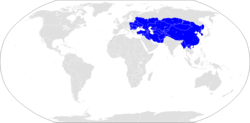




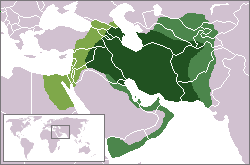
- Mongol Empire - 33.0 million km2 (1270 or 1309)[5]
- Yuan Dynasty - 14.0 million km2 (1310)[3]
- Umayyad Caliphate - 13.0 million km2 (720 or 750)[15]
- Abbasid Caliphate - 11.1 million km2 (750)[3]
- Rashidun Caliphate - 9.0 million km2 (654)[3]
- Sassanid Empire - 7.4 million km2 (620)[2]
- Ming Empire, China - 6.5 million km2 (1450)[2][3]
- Göktürk Khaganate - 6.0 million km2 (557)[2][22]
- Golden Horde Khanate - 6.0 million km2 (1310)[2][3]
- Uyghur Khaganate - 5.5 million km2 (800)[2][3]
- Tang Empire, China - 5.4 million km2 (715)[2][3]
- Fatimid Caliphate - 5.1 million km2 (969)[2][3]
- Tufan (Tibet) Empire - 4.6 million km2 (800)[2][3]
- Timurid Empire - 4.6 million km2 (1405)[2][3]
- Pala Empire, India - 4.0 million km2 (850)[citation needed]
- Eastern Turks Khanate - 4.0 million km2 (624)[22]
- Western Turks Khanate - 4.0 million km2 (600)[22]
- Karkota Dynasty (Kashmir), India - 4.0 million km2 (750)[2][3]
- Great Seljuq Empire - 3.9 million km2 (1080)[2][3]
- Ilkhanate - 3.75 million km2 (1310)[2][3]
- Chola Dynasty, India - 3.6 million km2 (1050)[35][36]
- Khwarazmian Empire - 3.6 million km2 (1218)[3][53]
- Chagatai Khanate - 3.5 million km2 (1310 or 1350)[2][3]
- Justinian Dynasty (Byzantine Empire) - 3.5 million km2 (555)[22]
- Northern Yuan Empire, Mongolia - 3.5 million km2 (1400)[3]
- Song Dynasty (Northern Song), China- 3.5 million km2 (1100)[2][3]
- Ghaznavid Empire, Persia - 3.4 million km2 (1029)[2][3]
- Almoravid Caliphate - 3.3 million km2 (1147)[3][54]
- Tughlaq Dynasty, India - 3.2 million km2 (1320)[3]
- Ghurids Sultanate, Persia - 3.2 million km2 (1200)[3]
- Sui Dynasty, China - 3.1 million km2 (610)[3]
- Khazar Khanate - 3.0 million km2 (850)[2][55]
- Kalmar Union - 3.0 million km2 (1397)[citation needed]
- Kievan Rus' - 3.0 million km2 (1050)[2][3]
- Kara-Khanid Khanate - 3.0 million km2 (1025)[3]
- Samanid Dynasty, Persia - 2.85 million km2 (928)[2][3]
- Ayyubid Caliphate - 2.7 million km2 (1190)[2][56]
- Majapahit Empire (Indonesia) - 2.7 million km2 (1389)[22]
- Khilji Dynasty, India - 2.7 million km2 (1312 or 1320)[2][3]
- Liao Dynasty, China - 2.6 million km2 (947)[2][3]
- Kara-Khitan Khanate(Western Liao) - 2.5 million km2 (1210)[2][57]
- Jin Dynasty(Jurchen), China) - 2.3 million km2 (1126)[2][3]
- Southern Qi Dynasty, China - 2.3 million km2 (502)[22]
- Southern Song Dynasty, China - 2.1 million km2 (1127)[3]
- Bahriyya Mamluks, Egypt - 2.1 million km2 (1300)[3]
- Burjiyya Mamluks, Egypt - 2.1 million km2 (1400)[2][58]
- Saffarid Dynasty, Persia - 2.0 million km2 (900)[citation needed]
- Ottoman Empire - 2.0 million km2 (1480)[2][3]
- Almohad Caliphate - 2.0 million km2 (1200)[2][59]
- Pratihara Dynasty, India - 1.8 million km2 (860)[3]
- Rashtrakuta Dynasty, India - 1.7 million km2 (805)[citation needed]
- Buyid Sultanate, Persia - 1.6 million km2 (980)[2][3]
- Mamluk Sultanate, India - 1.6 million km2 (1228)[3]
- Northern Zhou Dynasty, China - 1.5 million km2 (577)[22]
- Tulunids Emirate - 1.5 million km2 (900)[22]
- Idrisid Dynasty, Morocco - 1.5 million km2 (828)[2]
- Songhai Empire - 1.4 million km2 (1500)[45]
- Macedonian Dynasty (Byzantine Empire) - 1.35 million km2 (1025)[2][22]
- Harsha Empire (Pusyabhutis), India - 1.35 million km2 (625 or 648)[2][3]
- Liang Dynasty, China - 1.3 million km2 (502 or 549)[2][22]
- Western Wei Dynasty, China - 1.3 million km2 (557)[22]
- Later Liang Dynasty, China - 1.3 million km2 (923)[3]
- Later Tang Dynasty, China - 1.3 million km2 (923)[3]
- Mali Empire - 1.29 million km2 (1312)[46]
- Carolingian Dynasty, Francia - 1.2 million km2 (814)[2][3]
- Srivijaya Empire - 1.2 million km2 (1200)[2]
- Chalukya Dynasty, India - 1.1 million km2 (636)[citation needed]
- Eastern Wei Dynasty, China - 1.0 million km2 (550)[22]
- Northern Qi Dynasty, China - 1.0 million km2 (550)[22]
- Tahirid Dynasty, Persia - 1.0 million km2 (800)[3]
- Holy Roman Empire - 1.0 million km2 (1050)[3]
- Western Xia Dynasty (Tangut), China - 1.0 million km2 (1100)[2]
- Western Chalukya Empire, India - 1.0 million km2 (1121)[citation needed]
- Khmer Empire - 1.0 million km2 (1290)[2][3]
- Kalachuri Dynasty, India - 1.0 million km2 (1050)[2][3]
- Avars Empire - 1.0 million km2 (600)[22]
- Kanem Empire, Chad - 1.0 million km2 (1200)[3]
- Volga Bulgars Khanate - 0.9 million km2 (1100)[2][3]
- Later Jin Dynasty, China - 0.8 million km2 (936)[3]
- Ghana Empire - 0.8 million km2 (1067)[22]
- Pagan Kingdom (Bagan), Burma - 0.8 million km2 (1200)[3]
- Balhae Kingdom, Korea - 0.8 million km2 (830)[2]
- Merovingian Dynasty, Francia - 0.7 million km2 (558)[3]
- Yadava (Gauli) Kingdom, India - 0.7 million km2 (1250)[3]
- Bulgarian Empire - 0.7 million km2 (900)[citation needed]
- Paramara Dynasty, India - 0.7 million km2 (1050)[22]
- Kingdom of Dali (Hou li), China - 0.7 million km2 (1200)[citation needed]
- Kingdom of Nanzhao, China - 0.7 million km2 (830)[22]
- Visigoths Kingdom - 0.6 million km2 (580)[22]
- Caliphate of Córdoba - 0.6 million km2 (1000)[3]
- Rai Dynasty (Chachas) (Sindh), India - 0.6 million km2 (675 AD)[22]
- Maukhari (Kannauj) Dynasty, India - 0.6 million km2 (600 AD)[3]
- Bahmani Sultanate, India - 0.6 million km2 (1470 AD)[3]
- Later Han Dynasty, China - 0.5 million km2 (947)[3]
- Pandyan Dynasty, India - 0.5 million km2 (1251)[citation needed]
- Ostrogothic Kingdom - 0.5 million km2 (510 AD)[3]
- Latin Empire - 0.35 million km2 (1204)[22]
- Palailogan Dynasty (Byzantine Empire)- 0.3 million km2 (1300)[31]
- Serbian Empire - 0.25 million km2 (1350)[citation needed]
Modern empires


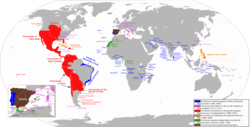
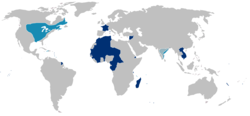

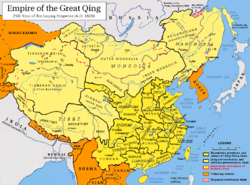


- British Empire - 33.7 million km2 (1946)[60][61]
- Russian Empire - 23.7 million km2 (1866)[2][3]
- Spanish Empire - 20.0 million km2 (ca. 1740-1790)[9][62]
- Ottoman Empire - 19.9 million km2 (1595)[2][3]
- Qing Empire, China - 14.7 million km2 (1790)[2][3]
- Second French Colonial Empire - 12.3 million km2 (1938)[9][63]
- Portuguese Empire - 10.4 million km2 (1815)[9][64]
- Empire of Brazil - 8.5 million km2 (1880)[9]
- Japanese Empire - 7.4 million km2 (1942)[9]
- Northern Yuan Empire, Mongolia - 5.0 million km2 (1550)[3]
- Ming Empire, China - 5.0 million km2 (1540)[2][3]
- First Mexican Empire - 4.9 million km2 (1822)[65]
- Mughal Empire, India - 4.6 million km2 (1690)[2][3]
- Afsharid Dynasty, Persia - 4.0 million km2 (1747)[citation needed]
- Italian Empire - 3.8 million km2 (1940)[citation needed]
- Dutch Empire - 3.7 million km2(1940)[citation needed]
- Nazi German Empire - 3.6 million km2 (1942)[citation needed]
- German Empire - 3.5 million km2 (1914)[citation needed]
- Safavid Dynasty, Persia - 3.5 million km2 (1512)[citation needed]
- Shaybanid (Uzbek) Dynasty - 3.5 million km2 (1510)[3]
- First French Colonial Empire - 3.4 million km2 (1670)[3]
- Danish colonial empire - 3.0 million km2 (1800)[citation needed]
- Qajar Dynasty, Persia - 3.0 million km2 (1796)[citation needed]
- Grand Duchy of Moscow - 3.0 million km2 (1505)[citation needed]
- Belgian Empire - 2.5 million km2 (1914)[citation needed]
- Maratha Empire, India - 2.5 million km2 (1760)[2]
- First French Empire - 2.1 million km2 (1813)[3]
- Inca Empire - 2.0 million km2 (1527)[2][3]
- Sibir Khanate - 1.8 million km2 (1520)[3]
- Suri Dynasty ,India - 1.5 million km2 (1545 AD)[2][3]
- Polish-Lithuanian Empire - 1.2 million km2 (1650)[2][3]
- Thai Empire (Siam Empire) - 1.12 million km2 (1782)[citation needed]
- Lodhi Dynasty, India - 1.1 million km2 (1517 AD)[citation needed]
- Swedish Empire - 1.1 million km2 (1658)[citation needed]
- Konbaung Dynasty, Burma - 0.9 million km2 (1800 AD)[citation needed]
- Khanate of Kazan - 0.7 million km2 (1540)[3]
- Vijayanagara (Tuluvas) Empire, India - 0.7 million km2 (1529)[citation needed]
- Austro-Hungarian Empire - 0.676615 million km2[citation needed]
- Nizams Dynasty, India - 0.6 million km2 (1740 AD)[citation needed]
- Sikh Empire, India - 0.5609 million km2 (1845)[citation needed]
- Crimean Khanate - 0.4 million km2 (1500)[3]
- Aztec Empire - 0.22 million km2 (1520)[3]
Largest empires by economy
GDP estimates in the following list are mostly given for empires in modern times, from the 18th to 20th centuries. All dollar amounts are in 1990 USD.
GDP size
- British Empire - $918.7 billion (in 1938)[4]
- Nazi German Empire - $375.6 billion (in 1938)[4]
- Japanese Empire - $260.7 billion (in 1938)[4]
- Russian Empire - $257.7 billion (in 1913)[8]
- Qing Empire, China - $241.3 billion (GDP decline to 1912, immediately before its downfall)[8]
- French Empire - $234.1 billion (in 1938)[4]
- Italian Empire - $143.4 billion (in 1938)[4]
- British India - $134.9 billion (in 1870)[8]
- Afsharid Empire, Persia - $119.85 billion (in 1740)[8]
- Austro-Hungarian Empire - $100.5 billion (in 1913)[66]
- Mughal Empire, India - $90.8 billion (GDP decline in 1700)[8]
- Dutch Empire - $60 billion (in 1900)
- Ottoman Empire - $26.4 billion (in 1913)[67]
- Portuguese Empire - $12.6 billion (in 1913)[66]
This section's factual accuracy is disputed. (January 2010) |
See also
- Empire
- List of empires
- Historical powers
- List of historical countries and empires spanning more than one continent
- List of countries by area
- List of countries by GDP
- List of countries by population
- List of extinct states
- List of political and geographic subdivisions by total area
- European empires
- African empires
- The World Economy: Historical Statistics
Notes and references
- ^ CIA - The World Factbook(The total is 148.94).
- ^ a b c d e f g h i j k l m n o p q r s t u v w x y z aa ab ac ad ae af ag ah ai aj ak al am an ao ap aq ar as at au av aw ax ay az ba bb bc bd be bf bg bh bi bj bk bl bm bn bo bp bq br bs bt bu bv bw bx by bz ca cb cc cd ce cf cg ch ci cj ck cl cm cn co cp cq cr cs ct cu cv cw cx cy cz da db dc dd de df dg dh di dj dk dl dm dn do Peter Turchin, Thomas D. Hall and Jonathan M. Adams, "East-West Orientation of Historical Empires", Journal of World-Systems Research Vol. 12 (no. 2), pp. 219-229 (2006).
- ^ a b c d e f g h i j k l m n o p q r s t u v w x y z aa ab ac ad ae af ag ah ai aj ak al am an ao ap aq ar as at au av aw ax ay az ba bb bc bd be bf bg bh bi bj bk bl bm bn bo bp bq br bs bt bu bv bw bx by bz ca cb cc cd ce cf cg ch ci cj ck cl cm cn co cp cq cr cs ct cu cv cw cx cy cz da db dc dd de df dg dh di dj dk dl dm dn do dp dq dr ds dt du dv dw dx dy dz ea eb ec ed ee ef eg Rein Taagepera "Expansion and Contraction Patterns of Large Polities: Context for Russia", International Studies Quarterly Vol. 41, 475-504 1997.
- ^ a b c d e f g h i Harrison (1998, pp. 3,7).
- ^ a b http://www.eeb.uconn.edu/people/turchin/PDF/Latitude.pdf
- ^ The combined population of China and Korea in the 13th century was 83 in Biraben (2003[page needed]). The combined population of Eastern Europe, Russia, Central Asia, Iran, Iraq and Turkey was about 27 in Maddison (2006[page needed]).
- ^ Biraben, Jean-Noel; Biraben, Jean-Noel (1979-01). "Essai sur l'evolution du nombre des hommes". Population (French Edition). 34 (1). Institut National d'É: 13–25. doi:10.2307/1531855.
{{cite journal}}: Check date values in:|date=(help) - ^ a b c d e f g h i j k l m n o p q r s Maddison, op cit. For alternate estimates, see the Economic History Services' USA/UK GDP search tool.
- ^ a b c d e f g h i j Gordon (2005)
- ^ The combined population of Spain, Portugal, Italy, Netherlands, United States and the Philippines was 29.2 in Maddison (2006[page needed]). The population of Latin America was 39 in Biraben (2003[page needed]), minus Brazil and its 4 people with was a part of the Portuguese empire.
- ^ "Russian Census of 2010". Federal State Statistics Service. Retrieved 27 Oct. 2010.
{{cite web}}: Check date values in:|accessdate=(help) - ^ Recorded number of persons in 1851 is 432,164,047 according to Draft History of Qing.
- ^ a b c d e f g h (a) John D. Durand, 1960, "The Population Statistics of China, A.D. 2–1953," Population Studies Vol. 13 (No. 3), 209–256. (b) John D. Durand, 1974, "Historical Estimates of World Population: An Evaluation," University of Pennsylvania, Population Center, Analytical and Technical Reports, Number 10.
- ^ Recorded number of persons and households in 1290 are 58,834,711 and 13,196,206, respectively (History of Yuan), while recorded peak number of persons and households are 59,848,964 and 13,430,322 in 1291, respectively (History of Yuan).
- ^ a b Blankinship, Khalid Yahya (1994). The End of the Jihad State, the Reign of Hisham Ibn 'Abd-al Malik and the collapse of the Umayyads. State University of New York Press. p. 37. ISBN 0791418278.
- ^ The combined population of Southwest Asia and North Africa was about 57 in Biraben (2003[page needed]). The combined population of Spain and Portugal was about 5 in Maddison (2006[page needed]).
- ^ a b McEvedy and Jones (1978).
- ^ Rashidun Caliphate
- ^ a b Vasseghi, Sheda, "The other Iran story: Re-engineering the nation's cultural DNA", Breaking... WorldTribune.com World Tribune News, (12 October 2009).
- ^ a b While estimates for the Achaemenid Empire range from 10–80+ , most prefer 50 . Prevas (2009, p. 14) estimates 10 1. Langer (2001, p. 40) estimates around 16 2. McEvedy and Jones (2001, p. 50) estimates 17 3. Strauss (2004, p. 37) estimates about 20 4. Ward (2009, p. 16) estimates at 20 5. Aperghis (2007, p. 311) estimates 32 6. Scheidel (2009, p. 99) estimates 35 7. Zeinert (1996, p. 32) estimates 40 8. Rawlinson and Schauffler (1898, p. 270) estimates possibly 50 9. Astor (1899, p. 56) estimates almost 50 10. Lissner (1961, p. 111) estimates probably 50 11. Milns (1968, p. 51) estimates some 50 12. Hershlag (1980, p. 140) estimates nearly 50 13. Yarshater (1996, p. 47) estimates by 50 14. Daniel (2001, p. 41) estimates at 50 15. Meyer and Andreades (2004, p. 58) estimates to 50 16. Pollack (2004, p. 7) estimates about 50 17. Jones (2004, p. 8) estimates over 50 18. Safire (2007, p. 627) estimates in 50 19. Dougherty (2009, p. 6) estimates about 70 20. Richard (2008, p. 34) estimates nearly 70 21. Mitchell (2004, p. 16) estimates over 70 22. Hanson (2001, p. 32) estimates almost 75 23. West (1913, p. 85) estimates about 75 24. Zenos (1889, p. 2) estimates exactly 75 25. Cowley (1999 and 2001, p. 17) estimates possibly 80 26. Cook (1904, p. 277) estimates exactly 80 27.
- ^ Historical Estimates of World Population U.S. Census Bureau.
- ^ a b c d e f g h i j k l m n o p q r s t u v w x y z aa ab ac ad ae af ag ah ai aj ak al am an ao ap aq ar as at au av aw ax ay az ba bb bc bd be bf bg bh bi bj bk bl bm bn bo bp bq br bs bt bu bv bw bx by bz ca cb cc cd ce cf cg ch ci cj ck cl cm cn co cp cq cr cs ct cu Rein Taagepera "Size and Duration of Empires: Growth-Decline Curves, 600 B.C. to 600 A.D.", Social Science History Vol. 3, 115-138 (1979).
- ^ Recorded number of persons and households in AD 2 are 59,594,978 and 12,233,062, respectively (Book of Han).
- ^ Jean-Noël Biraben, "The History of the Human Population From the First Beginnings to the Present" in Demography: Analysis and Synthesis: A Treatise in Population (Eds: Graziella Caselli, Jacques Vallin, Guillaume J. Wunsch), Vol. III, Chapter 66, pp 5-18, Academic Press:San Diego (2005).
- ^ Recorded number of persons and households in 1393 are 60,545,812 and 10,652,870, respectively (Ming Hui Dian), while recorded peak number of persons and households are 66,598,337 and 11,415,829 in 1403, respectively (Book of Ming).
- ^ a b Steele, Christy, "Rome", p. 36 (2001).
- ^ Mclynn Frank "Marcus Aurelius" p. 4. Published by The Bodley Head 2009
- ^ There are several different estimates for the Roman Empire. Scheidel (2006, p. 2) estimates 60 . Goldsmith (1984, p. 263) estimates 55 . Beloch (1886, p. 507) estimates 54 . Maddison (2006, p. 51, 120) estimates 48 . Roman Empire Population estimates 65 (while mentioning several other estimates between 55 and 120 ).
- ^ Mclynn Frank "Marcus Aurelius" p.4. Published by The Bodley Head 2009
- ^ Recorded number of persons and households in 755 are 52,919,309 and 8,914,709, respectively (Book of Tang).
- ^ a b c d e f g h i j k l m n o p q r s t u v w x y z aa ab ac ad ae af ag ah ai aj ak al am an ao ap aq ar as at au av aw ax ay az ba bb bc bd be bf bg bh bi bj bk bl bm bn bo bp bq br bs Rein Taagepera "Size and Duration of Empires Growth-Decline Curves, 3000 to 600 B.C.", Social Science Research Vol. 7, 180-196 (1978).
- ^ Colin McEvedy and Richard Jones (1978), "Atlas of World Population History", Facts on File (p. 342-351). New York.
- ^ Thomlinson (1975, Table 1).
- ^ a b Claudio Cioffi-Revilla, J. Daniel Rogers, Steven P. Wilcox, & Jai Alterman, "Computing the Steppes: Data Analysis for Agent-Based Modeling of Polities in Inner Asia", Proceedings of the 104th Annual Meeting of the Amer. Pol. Sci. Assoc., Boston, MA, p. 8 August 28–31, (2008).
- ^ a b [1]
- ^ a b "The Cholas"" University of Madras"K. A. Nilakanta Sastri
- ^ Recorded number of persons and households in 1195 are 48,490,400 and 7,223,400, respectively (History of Jin).
- ^ Recorded number of persons and households in 1103 are 45,981,845 and 20,524,065, respectively (Song Huiyao), while recorded peak number of persons and households are 46,734,784 and 20,882,438 in 1109, respectively (Song Huiyao).
- ^ "India at a glance: Population". Census of India, 2001. Government of India. Retrieved 25 April 2009.
- ^ Recorded number of persons and households are 46,019,956 and 8,907,546, respectively, in 606 (Tongdian) or 609 (Book of Sui).
- ^ Recorded number of persons and households in 1193 are 27,845,085 and 12,302,873, respectively (Wenxian Tongkao), while recorded peak number of persons and households are 28,320,085 and 12,670.801 in 1223, respectively (Wenxian Tongkao).
- ^ Recorded number of persons and households in 156 are 56,486,856 and 10,677,960 respectively (Book of the Later Han).
- ^ Department of Economic and Social Affairs
Population Division (2009). "World Population Prospects, Table A.1" (PDF). 2008 revision. United Nations. Retrieved 12 March 2009.
{{cite journal}}: Cite journal requires|journal=(help); line feed character in|author=at position 42 (help) - ^ a b c d Rein Taagepera "Size and Duration of Empires: Systematics of Size", Social Science Research Vol. 7, 108-127 (1978).
- ^ a b John O. Hunwick: Timbuktu and the Songahy Empire: Al-Sa’di’s Ta’rikh Al-sudan Down to 1613 and other Contemporary Documents (Brill, 2003),p. xlix.
- ^ a b Hempstone, page 312
- ^ Walker, Sheila S., African roots/American cultures: Africa in the creation of the Americas, Published by Rowman & Littlefield, p. 127. (2001)
- ^ Parker, Philip, "The Empire Stops Here", p. 2 (2009).
- ^ Peak area estimated by Taagepera (1979) is 3.4 million km2 in 261 BC.
- ^ Peak area estimated by Taagepera (1979) and Turchin et al (2006) is 9.0 million km2 in 176 BC. As it should be noted, historians are divided on whether the Xiongnu was an empire, and modern consensus in the majority of reputable sources is that the Xiongnu did not exceed 5 million km2 at their greatest extent.
- ^ Peak area estimated by Turchin et al (2006) is 2.0 million km2 in AD 140.
- ^ Peak area estimated by Taagepera (1979) is 1.7 million km2 in AD 440.
- ^ Peak area estimated by Turchin et al (2006) is 2.3 million km2 in 1210.
- ^ Peak area estimated by Turchin et al (2006) is 1.0 million km2 in 1120.
- ^ Peak area estimated by Taagepera (1997) is 1.0 million km2 in 900.
- ^ Peak area estimated by Taagepera (1997) is 1.7 million km2 in 1200.
- ^ Peak area estimated by Taagepera (1997) is 1.0 million km2 in 1130.
- ^ Peak area estimated by Taagepera (1997) is 1.6 million km2 in 1400.
- ^ Peak area estimated by Taagepera (1997) is 1.5 million km2 in 1163.
- ^ Ferguson 2004, p. 15.
- ^ Peak area estimated by Taagepera (1997) is 35.5 million km2 in 1920.
- ^ Peak area estimated by Taagepera (1997) is 13.7 million km2 in 1780 or 1810.
- ^ Peak area estimated by Taagepera (1997) is 11.5 million km2 in 1920.
- ^ Peak area estimated by Taagepera (1997) is 5.5 million km2 in 1820.
- ^ "Mexican Empire". All Empires. Retrieved 2009-08-02.
{{cite journal}}: Cite journal requires|journal=(help) - ^ a b Broadberry and Harrison (2005).
- ^ Pamuk (2005[page needed]).
Bibliography
- Hempstone, Smith (2007). Africa, Angry Young Giant. Whitefish: Kessinger Publishing, LLC. pp. 664 pages. ISBN 0-54844-300-9.
- Jonathan M. Adams, Thomas D. Hall and Peter Turchin (2004). East-West Orientation of Historical Empires. University of Connecticut.
- J. Beloch (1886), Die Bevölkerung der griechisch–römischen Welt, Duncker and Humblot, Leipzig.
- Jean-Noël Biraben (2003). "The rising numbers of humankind", Populations & Societies 394.
- Roger Boesche (2003). "Kautilya’s Arthashastra on War and Diplomacy in Ancient India", The Journal of Military History 67 (p. 9–38).
- Stephen Broadberry and Mark Harrison (2005). The Economics of World War I. Cambridge University Press. ISBN 0-521-8521 2-9.
- Christopher Chase-Dunn, Alexis Álvarez, and Daniel Pasciuti (2002). Power and Size: Urbanization and Empire Formation in World-Systems Since the Bronze Age. University of California, Riverside.
- Ferguson, Niall (2004). Colossus: The Price of America's Empire. Penguin. ISBN 1594200130.
- Raymond W. Goldsmith (1984), "An estimate of the size and structure of the national product of the Early Roman Empire", Journal of the International Association for Research in Income and Wealth 30
- Bruce R. Gordon (2005). To Rule the Earth... (See Bibliography for sources used.)
- Mark Harrison (1998). The Economics of World War II: Six Great Powers in International Comparison.
- Angus Maddison (2001). The World Economy: A Millennial Perspective. OECD, Paris.
- Angus Maddison (2006). The Contours of the World Economy 1-2030 AD. Oxford University Press.
- Colin McEvedy and Richard Jones (1978), "Atlas of World Population History", Facts on File (p. 342-351). New York.
- Sevket Pamuk (2005), "The Ottoman Empire in World War I". In Stephen Broadberry and Mark Harrison (2005), The Economics of World War I, p. 112-136. Cambridge University Press. ISBN 0-521-8521 2-9.
- Donald Quataert (2005). The Ottoman Empire, 1700-1922.
- Walter Scheidel (2005). The monetary systems of the Han and Roman empires. Stanford University.
- Walter Scheidel (2006). Imperial state formation in Rome and China. Stanford University.
- Carla M. Sinopoli (2003). The Political Economy of Craft Production: Crafting Empire in South India, C. 1350-1650.
- Ralph Thomlinson (1975), Demographic Problems, Controversy Over Population Control, Second Edition.
- Dr Frances Wood (2006). China: The Three Emperors. Royal Academy.
- H. Yoon (1985). "An early Chinese idea of a dynamic environmental cycle", GeoJournal 10 (2), p. 211-212.
- K. A. Nilakanta Sastri.(1935)"The Cholas"" University of Madras.








